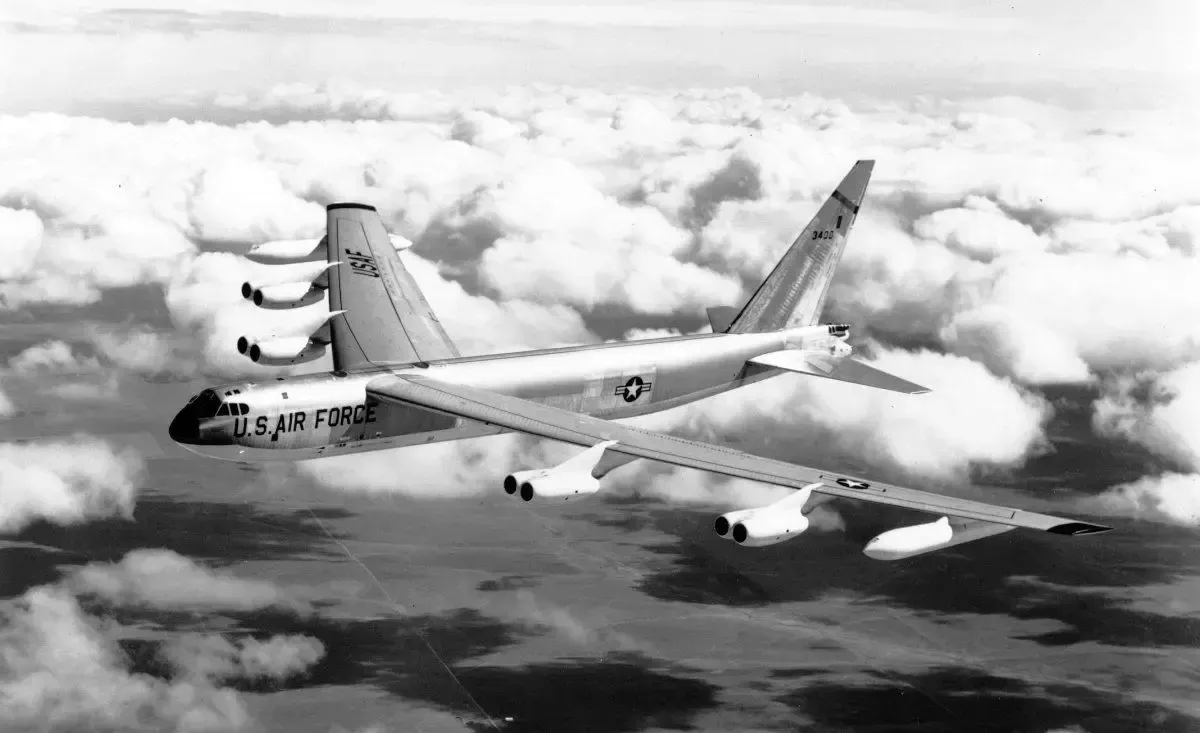
The Boeing B-52 Bomber History Explained
The Boeing B-52 Stratofortress was developed in the 1940s and 1950s. It is still in service.
Table of Contents
The American B-52 Stratofortress is a long-range strategic bomber developed by Boeing developed in the 1940s. The history of the B-52 bomber is a long and eventful one, and the aircraft is still in active service.
As a strategic bomber, the B-52 Stratofortress is an essential tool for the United States Air Force. Its purpose is to penetrate enemy territory and neutralize targets that hinder the enemy's ability to engage in war efforts.
Boeing developed the B-52 to carry nuclear weapons during the Cold War as part of the US nuclear deterrence effort. The United States Air Force has since deployed it in several other wars and conflicts.
As of September 2021, 76 B-52s are still in service, where the youngest is from the early 1960s. Boeing built 744 B-52 aircraft in total. Through several upgrades over the years, the USAF plans to keep the B-52 in service into the 2050s.
We take a look at the B-52 bomber history.
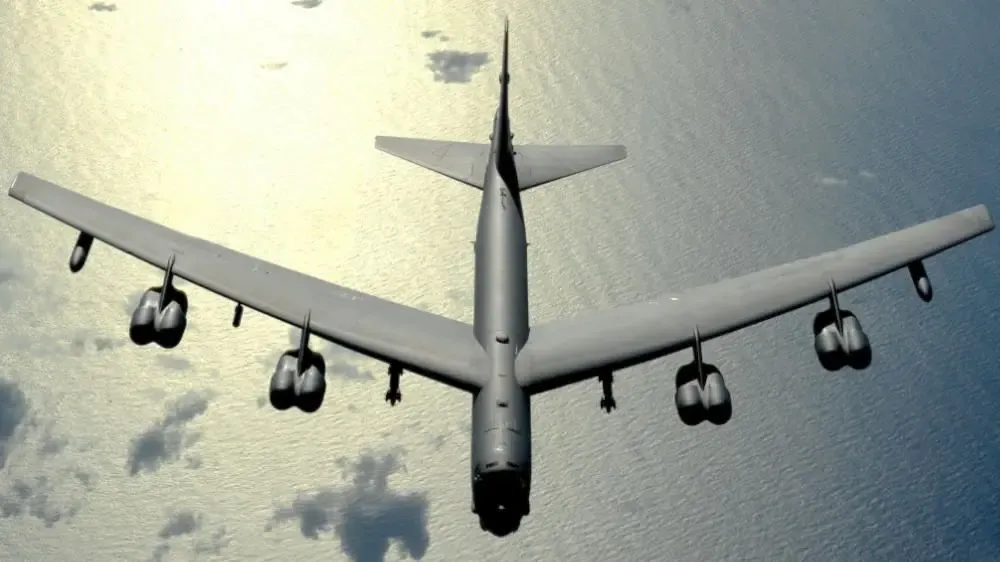
About the Boeing B-52 Stratofortress
The B-52 Stratofortress is an American long-range strategic bomber aircraft designed and built by Boeing in the late 1940s and early 1950s.
Its unique features include the easily recognizable 8-engine configuration, long swept wings, and its 70.000 pounds (32.000 kg) weapon capacity. The combat range also makes the plane stand out: over 8.800 miles (14.080 km) without mid-air refueling, which the B-52 can also do.
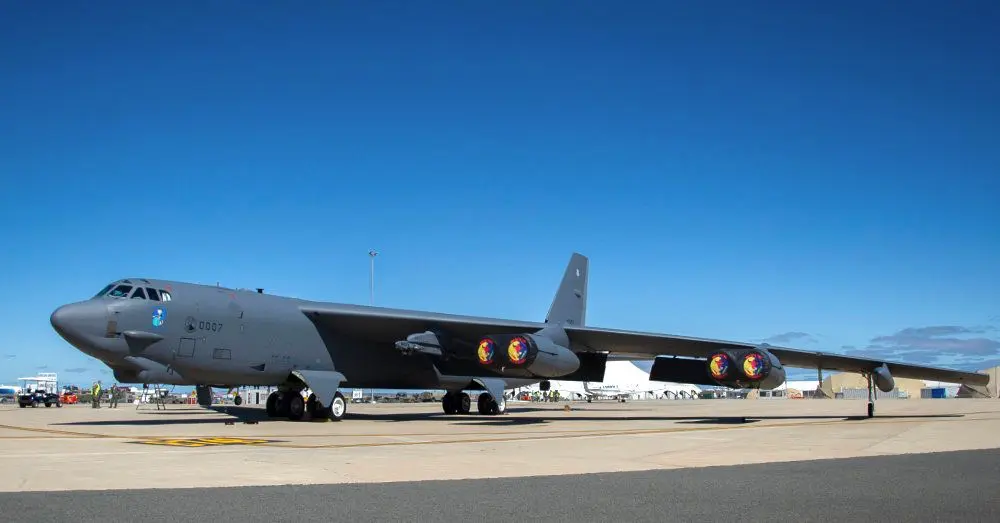
Boeing won the contract for the new bomber in 1946, and the newly developed aircraft had its maiden flight in 1952. Since then, Boeing has produced 744 B-52s. In 2019, 76 were still in service.
The B-52 bomber history is long, and it has been in service with the USAF since 1955. Boeing originally designed it to carry nuclear weapons in the Cold War, but the USAF has since modified it to accept other armaments, including bombs and missiles. Boeing has continued to provide upgrades and technical support for the aircraft, keeping it relevant and suitable over the many years.
As a veteran of many wars and conflicts, the B-52 has been around for decades. Its superior performance and relatively low operating costs have kept the B-52 in service. And it will stay in the air for decades to come. Through upgrades and modifications, the USAF expects the B-52 to remain in service into the 2050s.
It took several specifications and design changes during initial development to agree on the new B-52 Stratofortress. That caused the process to be lengthy as Boeing, and the United States Air Force discussed the performance requirements.
Origins
The USAF started looking for a new strategic bomber in November 1945 where they released a performance requirements specification for the new aircraft. One of the essential requirements was a combat radius of 5000 miles (8.000 km) and a cruise speed of 300 mph (480 km/h) at 34.000 feet altitude. The aircraft would be powered by propeller engines and crewed by five people.
In February the following year, the USAF invited potential manufacturers to submit their bids for the new aircraft. Consolidated Aircraft, Glenn L. Martin Company, and Boeing responded and submitted their design proposals.
Boeing won the bid with their "Model 462", a straight-wing bomber aircraft with six Wright T35 turboprop engines. However, the 462 did not meet the performance requirements as it would only be capable of a 3.110 mile (5.010 km) combat radius.
Together with the Model 462s high weight, the combat radius issue became a concern for the Air Force in October 1946. Boeing listened to the concerns and responded with a new "Model 464," which was smaller, had only four engines, and weighed less.
The USAF briefly accepted Boeing's Model 464. However, the USAF kept revising the performance requirements. In November 1946, General Curtis LeMay called for a higher cruising speed for the new aircraft and specified this to be 400 mph (645 km/h).
Being forced back to the drawing board, Boeing came up with yet another new design. But in December 1946, Boeing was asked to change this too. This time to a four-engine aircraft with a top speed of 400 mph (645 km/h) and a 12.000-mile (19.300 km) range. Notably, it should also be able to carry nuclear weapons.
This time Boeing responded with two designs, both powered by Wright T35 turboprop engines.
Model 464-16 was a nuclear-only bomber aircraft with a 10.000-pound (4.500 kg) payload capacity, while Model 464-17 was a general-purpose bomber with a 9.000-pound payload capacity.
Purchasing both aircraft would be too expensive. The USAF believed the Model 464-17 could be modified for nuclear strikes later and chose this design as a result.

But in June 1947, The United States Air Force changed the performance requirements again. Model 464-17 they had chosen over the -16 met all criteria, except the range. But that was not the only problem.
Despite the updated performance requirements, the Air Force realized that it would already be obsolete when the aircraft entered production. In addition, it would only offer a slight improvement over the Convair B-36 Peacemaker already in service. Subsequently, the USAF put the entire project on hold for six months.
However, Boeing continued to work on the design, improving the characteristics of the aircraft. The result was the Model 464-29 with a top speed of 435 mph (730 km/h) and a 5.000-mile (8.046 km) range.
Even though the Model 464-29 looked promising, the USAF changed its requirements once again. This time, the aircraft would need a top speed of 500 mph (800 km/h) and an 8.000-mile (13.000 km) range, far exceeding the capabilities of Boeing's Model 464-29.
Boeing now faced an outright cancellation of the entire project. But with the reasoning that the design was capable of adaptation to new technology and further requirements, Boeing convinced the USAF to continue the new bomber project.
During 1948, Boeing improved their design further, improving its characteristics. Their latest aircraft proposal could deliver a 513 mph (825 km/h) top speed and a range of 6.909 miles (11.125 km), and the ability to fly up to 35.00 feet (10.700 meters).
Development
The USAF and Boeing had previously discarded jet engines for the new bomber due to poor fuel efficiency. But in May 1948, the Air Force asked Boeing to incorporate the idea again as some models started to show improved efficiency.
Boeing came up with yet another new model, the 464-40, in July 1948. The USAF was impressed, but the government became concerned about the high fuel consumption. Jet engines were a relatively new invention back then, and fuel efficiency was poor. So this time, it was the government who intervened, asking Boeing to keep the turboprop engines. But Boeing was still encouraged to continue their turbojet studies.
In October 1948, Boeing presented a four-engine turboprop design to Colonel Pete Warden, chief of bomber development. He was not impressed with what he saw and expressed his disappointment to Boeing. Warden asked them to come up with a four-engine turbojet model instead.
He gave the Boeing engineers a very short deadline - one day.
So they worked all night in a hotel room in Dayton, Ohio, from October 21st to the 22nd, 1948. They managed to come up with a redesigned turbojet version of the new bomber.
However, Colonel Warden was still not impressed and asked for a better design. Boeing's engineering team returned to the hotel.
Later that same evening, Boeing engineers had come up with an entirely new design - essentially a completely new aircraft that exceeded all performance requirements. The Model 464-49 had swept wings and eight engines paired in four under-wing pods. The wingtips had outrigger wheels for stability on the ground. The Boeing team had even visited a local hobby store to buy materials for a model they built. A stenographer assisted them that Sunday to produce a copy of the design proposal.
On the following Monday, the team presented the Model 464-49 to Colonel Warden.
Despite the generally favorable reception, the range again became an issue due to the turbojet's fuel inefficiency. To solve this, Boeing created the Model 464-67, which, according to Boeing, could have its range increased through later modifications.
Finally, after years of design and specification revisions, Boeing was awarded a production contract in February 1951. The agreement was for 13 B-52A's, the first of many variants of the bomber.
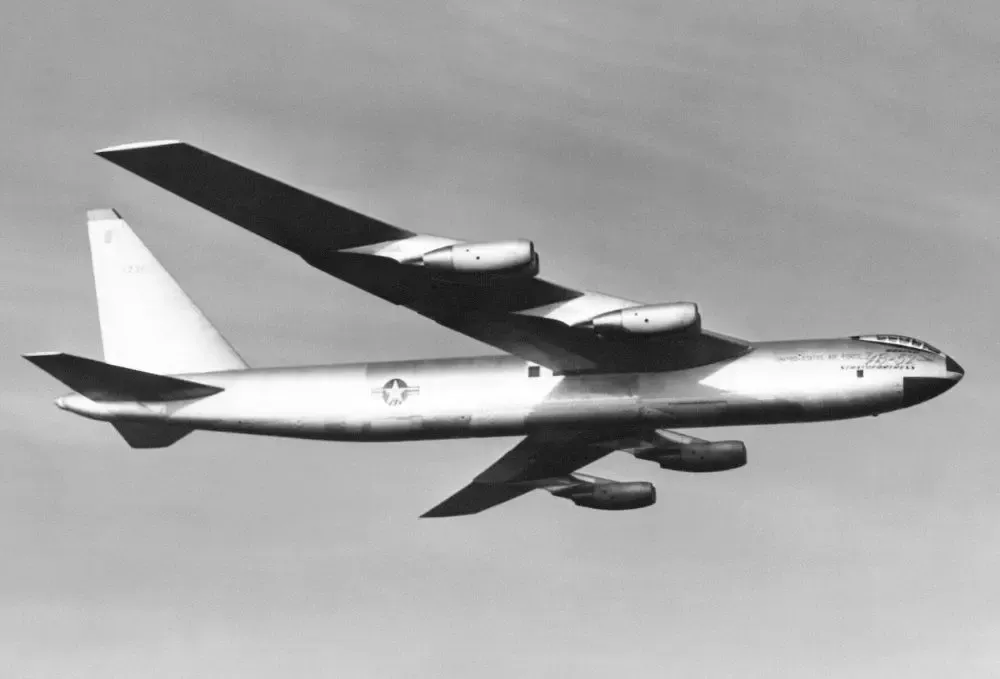
Production
The prototype of the new bomber aircraft, the YB-52, first flew on April 15th, 1952. Flight testing went smoothly thanks to thorough wind tunnel development and aerodynamical testing. The design exceeded the specifications, and the USAF was satisfied with the performance and placed an order of 282 aircraft.
Boeing built the B-52 Stratofortress in different variants over the years, starting with the B-52A through B-52H. Each variant offered improvements in range, power, and capabilities.
The Air Force initially ordered 13 of the B-52A model. However, Boeing eventually built only three, and the USAF returned them to Boeing for the testing program. The remaining ten aircraft of the contract were updated and constructed under the new B-52B variant specifications, and these were the first B-52s to enter active service.
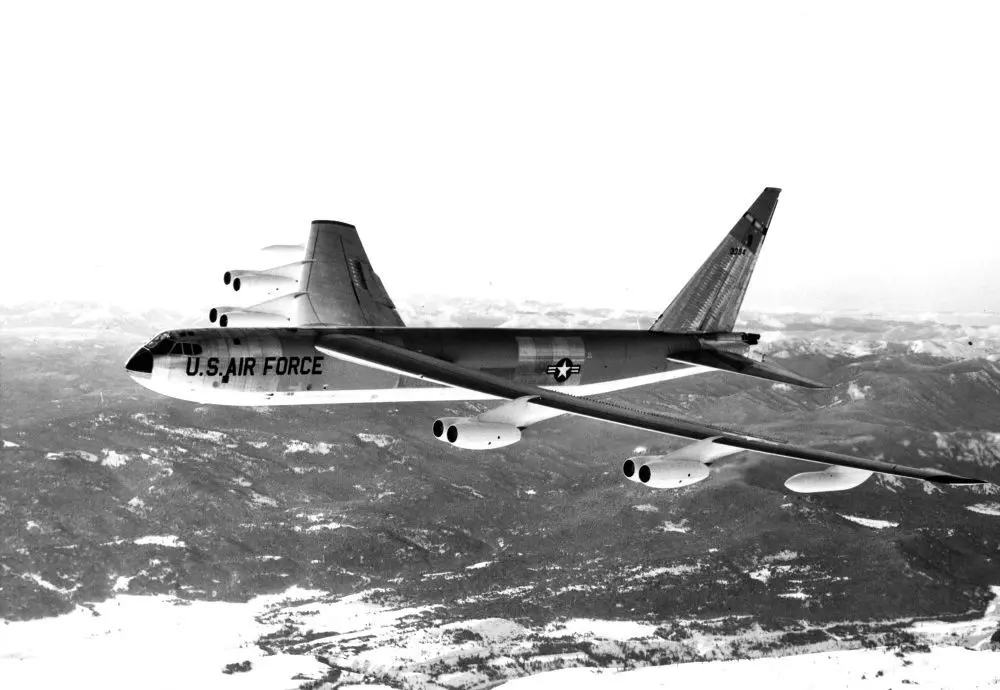
The B-52B was followed by continuously improving variants, culminating with the B-52G and B-52H, the latter being the final production variant. As the only variant, the B-52H came with more efficient turbofan engines, making it more fuel-efficient.
For a more rapid delivery of aircraft, Boeing had multiple production facilities set up. One at their main factory in Seattle, Washington, and one in Wichita, Kansas. Over 5.000 subcontractors were involved, and 41% of the airframe was built by companies other than Boeing.
Production ended in 1962, and at that time, Boeing had made 744 B-52 Stratofortress bombers across its eight variants since production began in 1952. Taking first place in numbers built was the B-52G model with 193 aircraft. The most productive year was 1958 when Boeing delivered 187 jets of the D, E, and F variants.
Upgrades
As the B-52 is an old aircraft, several upgrades and modifications have been necessary to keep it in service and meet the demands of the modern world. The large airframe allowed several upgrades over the years, and despite its beginning as a high-altitude nuclear bomber, the USAF has adapted it for changing needs.
The B-52H variant is the only remaining variant still in service, and the USAF plans to operate them into the 2050s. Because of their old age (Boeing built them in the early 1960s), the USAF has decided to upgrade them with new engines.
The USAF selected the Rolls-Royce BR725 engine (also called F130), a turbofan engine used for business jets and small regional airliners to power the B-52H into the future. They replace the TF33-P-3 turbofan engines and offer significant improvements in fuel efficiency and better reliability. Pratt & Whitney built the last TF33 engine in 1985.
Over the years, the B-52 has received a steady stream of upgrades. A new AESA (Active Electronically Scanned Array) radar system can detect more targets farther away, on the ground and in the air. It also comes with new radar displays in the cockpit.

New onboard computers also found their way to the B-52 Stratofortress, as well as new communication systems. Modern full-color LCDs in the cockpit and new communication links enable the B-52 to stream data in real-time, providing intelligence and mission information to other units.
The weapon systems also received an upgrade, and the B-52 can carry more weapons. Internal weapon storage capacity has more than doubled, and hardpoints under the wings allow the B-52 to take armaments there too.
The B-52 Stratofortress in Action
As a veteran of several wars, the B-52 bomber history is rich in action.
Early operations with the B-52 Stratofortress were problematic. Boeing and the USAF experienced supply issues and technical problems. Fuel systems were often leaking, weapon computers and engines were unreliable, and taxiways deteriorated under the aircraft's weight.
Technical issues also led to the first fatal B-52 crash in February 1956 due to an alternator failure. The Air Force subsequently grounded the B-52 fleet. Fleet groundings happened again in July 1956 as a result of fuel and hydraulics issues.
In May 1956, a Boeing B-52B Stratofortress dropped a nuclear bomb over the Bikini Atoll in a test. It was the first thermonuclear weapon to be air-dropped.
The first years of operations also saw several records broken by the B-52 Stratofortress. In September 1956, a B-52 without payload broke the world speed record with 595 mph (962 km/h) over 3.105 miles (5.000 km). Later, in January 1962, the bomber broke the distance record for flying unrefueled for 12.532 miles (20.177 km).
A B-52 had its vertical stabilizers ripped off the airframe when it encountered severe turbulence. The bomber landed safely despite the dangers associated with aircraft losing their vertical stabilizers.
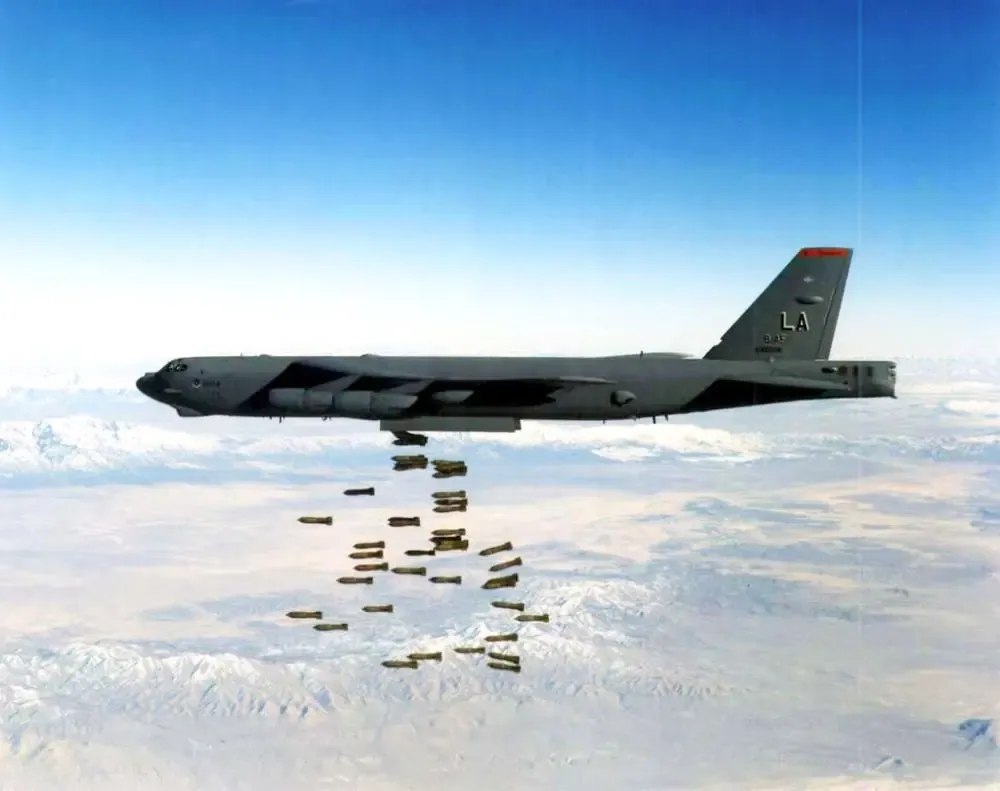
Cold War
The war part of the B-52 bomber history starts with the Cold War.
During the Cold War, the B-52's purpose was to deter and counter the increasing nuclear capabilities of the Soviet military. Destroying Soviet forces capable of delivering nuclear strikes was strategically important to the USAF.
The B-52 bombers performed high-altitude alert patrols near Soviet borders throughout the Cold War. In the event of a nuclear war, the B-52s could then perform first strikes or retaliation attacks.
But the primary effect was to deter Soviet nuclear strikes, preventing a large-scale nuclear war.
During the late 1950s, the USAF shifted to a low-altitude penetration role for the bomber, as surface-to-air missiles became a more advanced threat to high-altitude aircraft. Flying lower would better mask the radar signature in the terrain, providing efficient radar avoidance.
Vietnam War
In Vietnam, the B-52 bomber history takes a turn, as a B-52 was lost to enemy fire for the first time. It was hit by a SAM missile on November 22nd, 1972, forcing the crew to leave the aircraft over Thailand.
In Operation Arc Light, 30 B-52 set out to bomb a stronghold in South Vietnam. The first wave of B-52s arrived too early, and while waiting for the others, two B-52 bombers collided, resulting in the loss of eight crewmembers and both aircraft. Another bomber had to turn around due to mechanical problems.
Operation Linebacker II in late December 1972 saw the culmination of B-52 attacks. Several waves of B-52 bombers dropped 15.237 tons of bombs on Hanoi and other targets over 12 days. The operation involved 729 B-52 sorties. The enemy shot down 15 B-52s. Five sustained heavy damage, while five further sustained medium damage. Twenty-five crew members lost their lives.
The Stratofortress also participated in air-to-air combat as B-52 tail gunners shot down several MIG fighters. That makes the B-52 the largest aircraft to achieve an air-to-air kill.
In total, the US lost 31 Boeing B-52 bombers during the Vietnam War.
Gulf War
The B-52 was essential in Operation Desert Storm and was part of the initial attacks. On January 16th, several B-52Gs flew from the United States to hit targets in Iraq, refueling in the air underway and returning. A trip of 35 hours and 14.000 miles (23.000 km).
Iraqi forces saw their forces demoralized after the attacks, and many surrendered.
In total, the B-52s flew 1.620 sorties during Desert Storm. Of all bombs dropped by coalition forces, the B-52 dropped 40% of them.

Other Deployments
The B-52 has seen combat in other areas as well. It played a role in the Afghanistan War that began in 2001 and the invasion of Iraq in 2003.
In 2015, B-52s began a presence in the South China Sea, where China claims jurisdiction over their self-made islands, not recognized by the United States. In 2016 a B-52 flew over South Korea in response to the supposed hydrogen bomb tests by North Korea. It participated in the intervention against ISIS in 2016 and 2018 strikes against pro-government forces in Syria.
More Boeing B-52 Bomber History to Come
Boeing developed the B-52 Stratofortress in the 1940s and early 1950s. Through upgrades, the USAF plans to keep it in service into the 2050s. These updates, however, will not hold the bomber in the air forever.
Together with defense company Northrop Grumman, the USAF is developing a new "Long-Range Strike Bomber" that will eventually replace the Rockwell B-1 Lancer, Northrop Grumman B-2, and the Boeing B-52 Stratofortress.
Northrop Grumman calls it the B-21 Raider, and it will look similar to the already iconic B-2 Spirit, and develops it with stealth in mind. The USAF plans to introduce it into service by 2026-2027.
Until then, the USAF continues to rely on the Boeing B-52 Stratofortress. It is still a reliable, effective, and economical aircraft, and so far, there has been no dependable successor for it.
The B-52 bomber history has proved it to be a valuable asset for war and conflict. With new engines, the workhorse will extend its life into the 2050s while boosting fuel efficiency and range. If true, the Boeing B-52 Stratofortress will reach a service life of more than 90 years.
An extraordinary service length for any aircraft. Military or civilian.
Planenerd Newsletter
Join the newsletter to receive the latest updates in your inbox.






